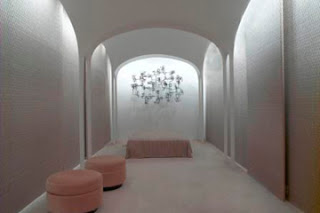 |
| Original 1949 floor plan of Johnson's Brick House |
 |
| Brick House in foreground, Glass House in back ground (c. 1949) |
In 1953 Johnson created the dramatic interior of the Brick House. The most important elements are the arched ceiling, supported by triangular pillars, and the Fortuny fabric, which hung as curtains, covering its walls. Johnson would use these elements in many of his subsequent projects, some of which can still be seen today. His choices in fabric and his architectural vision seem timeless. In fact, the Fortuny fabric he used nearly 60 years ago is still available from the company's active line.
Johnson's weekend estate underwent many changes throughout the decades. None were more dramatic than those that occurred in the 1980's; curtains became sliding panels, the fabric was stretched and stapled to these panels, the bed, floor and built-in bookshelves were all altered, all under the direction of Johnson, who was now in the early winter of his life.
 |
| Johnson's 1953 renovation - substantial changes only four years after the original construction. |
In 1986 the National Trust acquired the property and Johnson was allowed to remain in residence until his death in 2005.
What is in store for a historical landmark that has a history as rich and evolving as this? Here lies the dilemma: interpretation. Most historic sites are faced with common questions when the site undergoes restoration.
- Which elements are critical to the original concept?
- How have the elements changed over time?
(For example, has the Fortuny fabric altered sufficiently to no longer create the luminous quality Johnson intended? How are decisions reached for restoration, and are they consistent from room to room?)
As with most decisions, underlying issues are at play. One issue is mold and whether the levels are safe for visitors. The other is the period of interpretation.
 |
| Brick House bedroom 1953 with original Fortuny Fabric curtains and Ditzel wicker chairs |
WHICH TIME IS THE RIGHT TIME?
The National Trust states their period of interpretation is between 2001-2003, literally the final years of Johnson's life when the interior consisted of worn, fading and stained textiles and when Johnson was no longer actively working as both his sight and health were failing. When the site was nominated as a historic landmark in 1997, the period of significance was indicated as between 1949 and 1995, (an long stretch of time based on the dates which reflect Johnson's working years.)
Clearly these two periods of interpretation are in conflict and are the crux of the tension derived from such a decision. The site must decide what is important: that it be left as it was at the end of his life? Or restored to what he envisioned in 1953? Or the 1980's. Or perhaps some other time?
DILEMMAS:
While era for interpretation may be the main dilemma, other dilemmas exists, which may not be as obvious, but will directly impact the site and how it moves forward. Mold levels must be reduced, without this preventative step, the site may not be suitable for visitors. As for long term preservation: what will be the traffic flow into the building? How will it impact dust migration? How will this impact wear and tear on the textile elements? The Fortuny fabric covers every wall, it is a large component of the room and demands attention. Will the site staff maintain the NT's period and surface clean only? What about removal of the wall covering to treat it and return the original covering to the walls incorporated with with new mounting and backing? Lastly, the fabric could be completely removed and re-housed, replacing it with vibrant "reproductions" (remember that the EXACT fabric can still be purchased today - a rare circumstance).
Lastly, is this an "all or nothing" dilemma? Do all the pieces need to be treated or replaced? These are the issues any historical site faces when evaluating renovation. As a conservator, we must give our best professional opinion and be prepared to assist the site in whichever it chooses. Drawing on each aspect of conservation - treatment, re-housing, storage, preservation and stabilization - a site project of this magnitude provides both the challenge of dealing with these dilemmas, but most importantly, the opportunity to solve them.
This post by Barbara Owens is a summary of a talk given by Gwen Spicer called "Decoding the History of the Fortuny Fabric at Philip Johnson"s Brick House Interior" at the New England Conservation Association, held at the Shelburne Museum in 2010.
_____________________________
Gwen Spicer is a textile conservator in private practice. Spicer Art Conservation specializes in textile conservation, object conservation, and the conservation of works on paper. Gwen's innovative treatment and mounting of flags and textiles is unrivaled. To contact her, please visit her website.


No comments:
Post a Comment